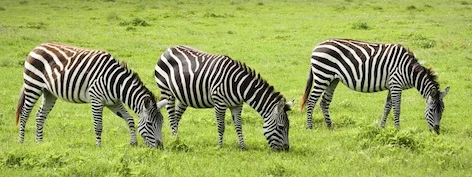Zebras are part of the horse family.
They have stripes.
Zebras eat grass.
They live in Africa.
A baby zebra is a foal. Its mother is a mare and its father is a stallion.
Photo©kidcyber
What is a zebra?
Zebras are part of the horse family, and are related to domestic horses.
They have a distinctive pattern of black and white stripes... but underneath their skin is black.
There are three main kinds of zebra:
A plains zebra: see the brownish stripes Getty Images
Plains, or common zebra (there are 4 kinds of plains zebra)
Their body shape is like that of a pony. Their bodies are wider at the rump, or tail end. Wide stripes stretch down to the belly. Some have brownish stripes as well as black. They are called 'shadow stripes'. Plains zebra live on the grasslands of Africa.
Conservation Status: of Least Concern
Mountain zebra (there are 2 kinds of mountain zebra)
Their stripes are thin and close together on neck and body, but on the rump they become wide, with big spaces between them. Mountain Zebra live in dry areas of southern Africa, in high places.
The stripes of a mountain zebra's rump are widely spaced. Getty Images
Conservation status: Vulnerable.
Grevy's zebra have big, rounded ears. Getty Images
Grevy's zebra
The largest of the zebra species. They have a long, narrow head with big rounded ears. There are lots of narrow stripes on the body and down the legs, and the belly is white. Grevy's zebra live in the dry areas of northeast Africa.
Conservation Status: Endangered
Body and Behaviours
No two zebra patterns are alike Getty
All species of zebra have strong bodies and legs, small hooves, big ears and stiff manes that are striped.
There are small differences in how the different kinds of zebra look. Some kinds have white legs, some have brownish 'shadow stripes' in between the black and white stripes, some have narrow stripes close together, some have leg stripes all the way down to the hooves, some have them halfway down. The Grevy's zebras are the largest, with large, rounded ears.
A newborn zebra foal. ©Getty Images
No two zebras have the same pattern, just like human fingerprints, each is unique. They can even have a different pattern on one side of their body to the other. We don't really know for sure why zebras have the patterns they do. One theory is that when a herd runs together a predator gets confused by the swirling black and white stripes. Another theory is that the air over the black stripes is warmer than the air over the white stripes, and so the warm and cool air swirl and fan the animal. This also creates a shimmer around the animal, making it harder for predators to see individuals.
Zebras are fast runners, and stay very alert all the time in case of danger. They kick hard with their hind legs. They have excellent eyesight, smell and hearing to help alert them to predators.
Location of the eyes help nervous zebra look out for danger. Getty
They have long jaws to help them hold big mouthfuls of food. Their eyes are located high on the head and at the side so that while they are grazing they can still look out for danger.
Most kinds of zebra live in family groups consisting of a stallion, 2-6 mares, and their foals. Large herds of zebra are usually made up of numerous families. Life is safer in a herd, with many animals alert to danger. If one member of the herd is in trouble, others will try to help. If one member is lost, all members rush around calling until it is found.
Diet
Zebras are herbivores, which means they eat only plants. They have very mobile lips which grip a tuft of grass while their front teeth cut it off. Their back teeth (molars) grind the grass. There is little nutrition in grass, and zebras are not ruminants like giraffes so they need to eat a lot in order to get enough nutrition. This means they graze for most of the day.
A zebra calf suckling milk from its mother. ©Getty Images
Life Cycle
A mare gives birth to a foal about 12 months after mating with a male. For at least two days, the mother keeps other zebras away from her newborn foal so that they learn to recognise each other's patterns. Foals have legs almost as long as an adult's so that one hour after birth a foal is able to run fast enough to keep up with the herd. Foals stay close to their mothers for protection. They suckle milk from their mothers.
It is always a good idea to use more than one source of information so: read more about zebras here
http://animalstime.com/zebra-facts-for-kids-zebra-diet-habitat-behavior-and-characteristics/










